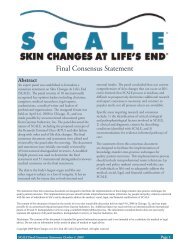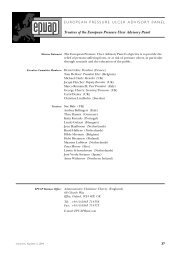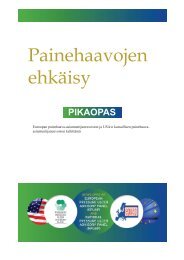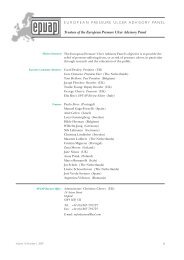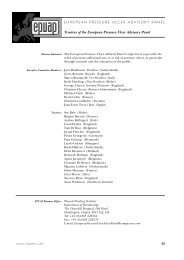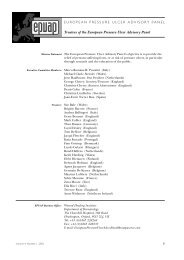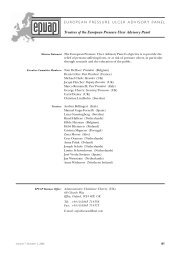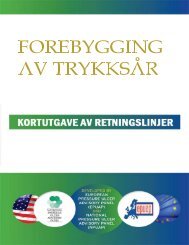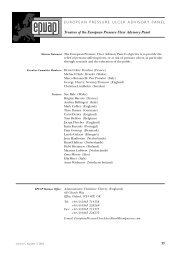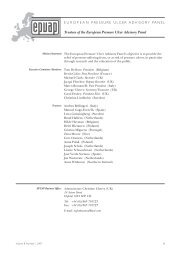EPUAP Review 5/2 RIP - European Pressure Ulcer Advisory Panel
EPUAP Review 5/2 RIP - European Pressure Ulcer Advisory Panel
EPUAP Review 5/2 RIP - European Pressure Ulcer Advisory Panel
You also want an ePaper? Increase the reach of your titles
YUMPU automatically turns print PDFs into web optimized ePapers that Google loves.
54<br />
epuap Guideline<br />
EUROPEAN PRESSURE ULCER ADVISORY PANEL<br />
Development Group<br />
NUTRITIONAL GUIDELINES REFERENCE LIST<br />
Abildgaard U, Daugaard K. <strong>Pressure</strong> sores. A prevalence<br />
investigation. Ugeskrift for Laeger 1979; 141(46): 3147–<br />
3151.<br />
Abruzzese RS. Guidelines for evaluating decubitus ulcer<br />
research.[comment]. Decubitus. 1989; 2(1): 28–32.<br />
Abruzzese R. What causes pressure ulcers to heal? Decubitus.<br />
1992; 5(1).<br />
Adam S, Forrest S. ABC of intensive care: other supportive<br />
care. Bmj. 1999; 319(7203): 175–8.<br />
Allman RM, Laprade CA, Noel LB, Walker JM, Moorer CA,<br />
Dear MR, et al. <strong>Pressure</strong> sores among hospitalized<br />
patients. Annals of Internal Med. 1986; 105(3): 337–42.<br />
Alonso JE, Lee J, Burgess AR, Browner BD. The management<br />
of complex orthopedic injuries. Surgical Clinics of<br />
North America 1996; 76(4): 879–903.<br />
Anonymous. Treatment of pressure ulcers: guideline<br />
overview. Agency for Health care Policy and Research<br />
Rockville, Maryland. Journal of the National Medical<br />
Association. 1995; 87(4): 253–4.<br />
Anonymous. Study may produce new best practices.<br />
Healthcare Benchmarks. 1997; 4(11): 161–2.<br />
Anonymous. [Optimal nutrition protects against decubitus<br />
ulcer]. Krankenpflege Journal. 2000; 38(6): 218–9.<br />
Anonymous. Aggressive nutrition intervention. Staff<br />
training is key to ensuring positive outcomes. Health<br />
Care Food & Nutrition Focus. 2001; 17(6): 12.<br />
Anthony D, Reynolds T, Russell L. An investigation into the<br />
use of serum albumin in pressure sore prediction.<br />
Journal of Advanced Nursing 2000; 32(2): 359–365.<br />
Antypas PG. Management of pressure sores. Current<br />
Problems in Surgery. 1980; 17(4): 229–44.<br />
Aquilani R, Boschi F, Contardi A, Pistarini C, Achilli MP,<br />
Fizzotti G, et al. Energy expenditure and nutritional<br />
adequacy of rehabilitation paraplegics with asymptomatic<br />
bacteiuria and pressure sores. Spinal Cord 2001;<br />
39(8): 437–41.<br />
Aquilani R. Prevalence of decubitus ulcer and associated<br />
risk factors in an institutionalized Spanish elderly<br />
population. Nutrition 2002; 18(5): 437–438.<br />
Aronovitch SA. A retrospective study of the use of specialty<br />
beds in the medical and surgical intensive care units of<br />
a tertiary care facility. Decubitus 1992; 5(1): 36–42.<br />
Austin G. Eating into resources. Nursing Times 1999; 95(11):<br />
64–67.<br />
Ayello EA, Thomas DR, Litchford MA. Wound care 1999.<br />
Nutritional aspects of wound healing. Home Healthcare<br />
Nurse 1999; 17(11): 719–30.<br />
Banks V. Nutrition and pressure area management. J of<br />
Wound Care. 1998; 7(6): 318–9.<br />
Barateau M, Corompt A, Soulan J, Bourdel-Marchasson I.<br />
Multicenter nurse study assessing the interest of a<br />
nutritional support in the prevention of bedsores in<br />
high-risk elderly [French]. Recherche en Soins Infirmiers<br />
1998; 55: 42–9.<br />
Barone EJ, Yager DR, Pozez AL, Olutoye OO, Crossland<br />
MC, Diegelmann RF, et al. Interleukin-1alpha and<br />
collagenase activity are elevated in chronic wounds.<br />
[comment]. Plastic & Reconstructive Surgery. 1998;<br />
102(4): 1023–7; discussion 1028–9.<br />
Bauman WA, Spungen AM. Body composition changes and<br />
anabolic hormone considerations with advancing age<br />
and in persons with spinal cord injury. Wounds A<br />
Compendium of Clinical Research & Practice 2001; 13(4)<br />
Benati G, Delvecchio S, Cilla D, Pedone V. Impact on<br />
pressure ulcer healing of an arginine-enriched nutritional<br />
solution in patients with severe cognitive impairment.<br />
Archives of Gerontology & Geriatrics 2001;<br />
33(SUPPL): 43–47.<br />
Bennett RG. <strong>Pressure</strong> ulcers. Clinical Geriatrics 2001; 9(2):<br />
70–5.<br />
Bergstrom N, Braden B. A prospective study of pressure<br />
sore risk among institutionalized elderly. J of the<br />
American Geriatrics Society. 1992; 40(8): 747–58.<br />
Bergstrom N. Lack of nutrition in AHCPR prevention<br />
guideline. Decubitus. 1993; 6(3): 4, 6.<br />
Bergstrom N, Allman RM, Alvarez OM, Bennett MA,<br />
Carlson CE, Frantz RA, et al. <strong>Pressure</strong> ulcer treatment.<br />
American Family Physician 1995; 51(5): 1207–22.<br />
Bergstrom NI. Strategies for preventing pressure ulcers.<br />
Clinics in Geriatric Medicine. 1997; 13(3): 437–54.<br />
Berlowitz DR, Wilking SVB. Risk factors for pressure sores.<br />
A comparison of cross-sectional and cohort-derived<br />
data. J of the American Geriatrics Society 1989; 37(11):<br />
1043–50.<br />
Bertrand F, Pras P. [Monitoring and care of an elderly<br />
hospitalized patient]. Soins – Cardiologie. 1984(18–19):<br />
27–34.<br />
Bildsten C, Lamid S. Nutritional management of a patient<br />
with brain damage and spinal cord injury. Archives of<br />
Physical Medicine & Rehabilitation. 1983; 64(8): 382–3.<br />
Bishara J, Leibovici L, Huminer D, Drucker M, Samra Z,<br />
Konisberger H, et al. Five-year prospective study of<br />
bacteraemic urinary tract infection in a single institution.<br />
<strong>European</strong> J of Clinical Microbiology & Infectious<br />
Diseases 1997; 16(8): 563–567.<br />
Volume 5, Number 2, 2003



